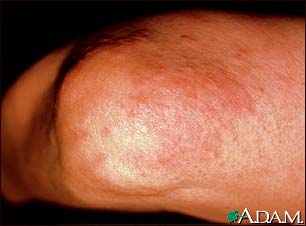Health Library
Granuloma annulare
Pseudorheumatoid nodule - subcutaneous granuloma annulare; GA
Granuloma annulare (GA) is a long-term (chronic) skin disease consisting of a rash with reddish bumps arranged in a circle or ring.
Images




I Would Like to Learn About:
Causes
GA most often affects children and young adults. It is slightly more common in females.
The condition is usually seen in otherwise healthy people. Sometimes, it may be associated with diabetes or thyroid disease. The exact cause of GA is unknown.
Symptoms
GA usually causes no other symptoms, but the rash may be slightly itchy.
People usually notice a ring of small, firm bumps (papules) over the backs of the forearms, hands, or feet. Occasionally, they may find a number of rings.
In rare cases, GA appears as a firm nodule under the skin of the arms or legs. In some cases, the rash spreads all over the body.
Exams and Tests
Your health care provider may think you have a fungal infection when looking at your skin as the ring shape may look like ringworm. A skin scraping and KOH test can be used to tell the difference between GA and a fungal infection.
You may also need a skin punch biopsy to confirm the diagnosis of GA.
Treatment
GA can resolve on its own. You may not need treatment for GA, except for cosmetic reasons. Very strong steroid creams or ointments are sometimes used to clear up the rash more quickly. Injections of steroids directly into the rings may also be effective. Some providers may choose to freeze the bumps with liquid nitrogen.
People with severe or widespread cases may need medicines that suppress the immune system. Laser and ultraviolet light therapy (phototherapy) may also help.
Outlook (Prognosis)
In most cases, GA disappears without treatment within 2 years. The rings can remain for many years. The appearance of new rings years later is not uncommon.
When to Contact a Medical Professional
Contact your provider if you notice ring-like bumps anywhere on your skin that do not go away within a few weeks.
Related Information
ChronicReferences
Dinulos JGH. Cutaneous manifestations of internal disease. In: Dinulos JGH, ed. Habif's Clinical Dermatology. 7th ed. Philadelphia, PA: Elsevier; 2021:chap 26.
Patterson JW. The granulomatous reaction pattern. In: Patterson JW, ed. Weedon's Skin Pathology. 5th ed. Philadelphia, PA: Elsevier; 2021:chap 8.
BACK TO TOPReview Date: 5/28/2024
Reviewed By: Ramin Fathi, MD, FAAD, Director, Phoenix Surgical Dermatology Group, Phoenix, AZ. Also reviewed by David C. Dugdale, MD, Medical Director, Brenda Conaway, Editorial Director, and the A.D.A.M. Editorial team.
 | A.D.A.M., Inc. is accredited by URAC, for Health Content Provider (www.urac.org). URAC's accreditation program is an independent audit to verify that A.D.A.M. follows rigorous standards of quality and accountability. A.D.A.M. is among the first to achieve this important distinction for online health information and services. Learn more about A.D.A.M.'s editorial policy, editorial process and privacy policy. A.D.A.M. is also a founding member of Hi-Ethics. This site complies with the HONcode standard for trustworthy health information: verify here. |
The information provided herein should not be used during any medical emergency or for the diagnosis or treatment of any medical condition. A licensed medical professional should be consulted for diagnosis and treatment of any and all medical conditions. Links to other sites are provided for information only -- they do not constitute endorsements of those other sites. No warranty of any kind, either expressed or implied, is made as to the accuracy, reliability, timeliness, or correctness of any translations made by a third-party service of the information provided herein into any other language. © 1997- 2025 A.D.A.M., a business unit of Ebix, Inc. Any duplication or distribution of the information contained herein is strictly prohibited.
